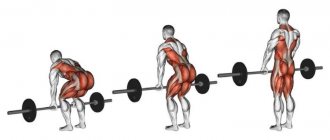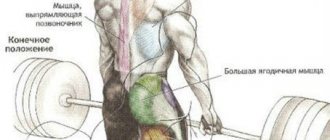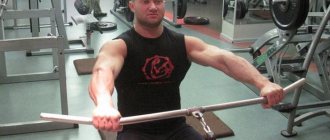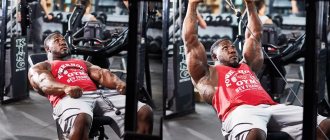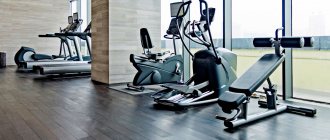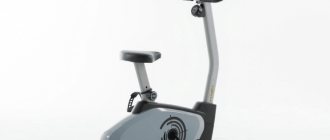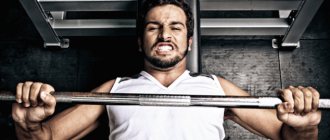- Execution technique
Deadlift involves a large number of muscles, which largely explains the high popularity of this exercise. It most actively involves the quadriceps and back muscle groups. In athletes, some muscles lag behind in their development, for example, if it is the back, then deadlifts from the block are necessary. In the case where the leg muscles are lagging behind in development, you should perform deadlifts from the pit. Today we will talk about the technique of performing these variants of a popular exercise.
Benefits of deadlifts for men
First of all, the deadlift serves to develop all major muscle groups, especially the back and hips. With this exercise you can develop strength and power, as weightlifters and powerlifters do, or use the exercise for general strengthening purposes.
The main advantage is the involvement of a large number of muscles and joints at the same time, which significantly increases the physical abilities of the athlete.
Complex basic exercises such as deadlifts or squats can increase testosterone levels, which gives the athlete a powerful anabolic boost and increases strength. Growth hormone is also produced, which helps increase muscle size.
Causes of delayed muscle development
For most athletes, muscles do not develop harmoniously and some muscles lag behind. There can be many reasons for this: non-compliance with the regime, incorrect training program, etc. Someone may simply pay insufficient attention, for example, to the legs, focusing on the chest or back. This is absolutely not the right approach to training.
Nutrition and rest play a very important role in bodybuilding. If on the day of back training you ate well and slept well, then the muscles will gain weight, but if on the day of working on the leg muscles you had poor sleep and did not manage to eat properly during the day, then there will be no result. For the harmonious development of your body, you should always follow diet and sleep patterns.
Of course, nutrition and training programs, as well as sleep, are far from the only reasons for possible muscle growth lag. Much depends on genetic predisposition. Every athlete has both strengths and weaknesses. All athletes have muscle groups that require more effort to grow. For these purposes, methods and exercises are created, such as deadlifts from a pit.
Harm and contraindications - is it worth doing deadlifts?
Deadlifts can cause damage and injury instantly if you do not follow the correct technique and select excessively heavy weights. If such mistakes are made, spinal injuries may occur - hernia, vertebral displacement, pinched nerves, and the like. All this can be avoided if you take good care of your health and follow all recommendations.
A common mistake when performing deadlifts is rounding the spine in the thoracic and lumbar regions; this occurs due to weakness in the core muscles, which are unable to stabilize the spine in the correct position. Also, incorrect technique is often facilitated by physiological characteristics - muscle flexibility, joint mobility, height, limb length. These factors can affect technique and, consequently, injury if these features are not taken into account in training and precautions are not taken.
The main contraindications are existing injuries and diseases of the spine, back pain.
Sumo or classic: the difference in technique
What is the difference between these two types of traction?
- Well, the answer is obvious: the position of the legs . Depending on the width of your legs, the height of the barbell changes. The wider the legs are spread, the lower the lifting height of the projectile. Those. By placing your feet wider, you simply make the task a little easier for yourself and reduce your range of motion.
- Typically, the classic deadlift is chosen by people with shorter legs and a longer torso. Still, the sumo style requires a certain flexibility and mobility in the hip and knee joints.
- The sumo deadlift engages all of the hip adductors more fully. The classic technique loads the back .
- Classic requires parallel placement of the feet. Sometimes trainers advise turning them slightly to the sides. When doing sumo deadlifts, your goal is to rotate your feet 45 degrees outward.
Both deadlift variations are equally good. If you are in doubt about the choice, experiment with both options. Only then will you be able to figure out what is more convenient for you to do. The sumo deadlift has its pros and cons, just like the classic one, so the choice between them is a purely individual matter and depends on your personal comfort.
Sumo deadlifts are usually more popular among women because... in this position, more load is given to the gluteal muscles. However, remember that while hip extension exercises like these do engage the glutes, they don't engage them fully—during a deadlift, the glutes are activated by 52%.
What muscles work when deadlifting?
- Quadriceps femoris muscles.
- Latissimus dorsi muscles.
- Teres major muscle.
- Gluteal muscles.
- Adductor muscles of the thigh.
- Biceps femoris muscle.
- Semitendinosus muscle.
- Semimembranosus muscle.
- Spinal extensor muscles.
- Trapezius muscle.
- Rhomboid muscle.
Technique for performing deadlifts with a barbell
I will focus on the importance of performing a good warm-up before performing deadlifts. The muscles need to be well warmed up and stretched.
Read more about warming up before training →
Let's look at the classic deadlift technique:
- Place the barbell on the floor, having previously hung the plates of the required weight.
- Stand in front of the barbell in the center, place your feet hip-width apart, and spread your toes slightly apart.
- Squat down, moving your pelvis back, grab the barbell with your hands shoulder-width apart so that your knees are between your hands.
- Don't forget to get up from the same position. To begin, straighten the line of your spine, slightly bending your lower back inward and pushing your chest forward.
- The shoulder line should extend forward beyond the bar.
- Squeeze your shoulder blades together, keep your head neutral, and don't rotate your head or throw it back.
- Take a breath before starting the movement. Mainly using the strength of your pelvis, begin to straighten your torso and rise up until your spine and knees are completely straight.
- Exhale at the top.
- Slowly return the bar to the floor, pulling the bar along your shin, without moving your pelvis back too far so that the load does not shift from your back.
Technique by type
Let's start analyzing the execution technique with the classics with a barbell:
Classic with barbell
The technique, of course, will be the same for men and women, but it is this classic option that is traditionally chosen by boys, because They care more about the overall development of muscles and strength, rather than targeting specific muscles.
How to do deadlifts with a barbell:
- Come close to the bar, place your feet narrower than your shoulders and parallel to each other (or place your feet wider than your shoulders - you will get a sumo deadlift with more load on the glutes).
- Squat down and grab the barbell with an overhand grip, the distance is slightly wider than shoulder width. The arms are vertical, the shoulders are under the barbell, the gaze is directed straight ahead.
- Take a deep breath and, as you exhale, begin to lift the barbell. The takeoff is smooth and even (no jerking from the floor), the bar slides along the legs, make sure that the bar moves along a vertical path and passes as close to the shins and hips as possible.
- Keep your back (as in a squat) strictly straight, with a natural arch in the lower back.
- After passing the barbell through your knees, you should straighten up completely, slightly squeeze your shoulder blades together, and proudly push your chest forward. Important point : the barbell does not need to be pulled with your hands; they act as cables.
- We return to the starting position. Lowering the barbell begins with bending your knees, moving your buttocks back and simultaneously lowering your straight back forward. It is very important to ensure that the back does not round , to keep it straight using the abdominal muscles and erector spinae, as well as the flattened shoulder blades.
Beginners need to strengthen their back and leg muscles before starting deadlifts. Do hyperextensions , pull-ups , squats and lunges .
On straight legs
What is the difference between classic deadlift and Romanian deadlift, what are the differences with the so-called. dead? Yes, everything: the stereotype of movement, the effect, even which muscles ultimately swing.
As for the deadlift on straight legs, which, according to the movement stereotype, is a complete analogue of the “good morning” bend over with a barbell on the shoulders or the Romanian deadlift, this version of the deadlift will not be a general strength exercise like the classic or sumo.
The technique of performing Romanian deadlifts on straight legs with a barbell and dumbbells is described in detail in this article .
This is a highly specialized exercise for the back extensors and hamstrings, and secondarily for the glutes. When performing deadlifts on straight legs, the impact on the spinal extensor muscles becomes dangerous, so deadlifts on straight legs should be performed extremely carefully and only under the supervision of a trainer .
And remember that “straight legs” is a relative definition, the knees should ALWAYS be slightly bent, and the barbell weights should be light.
With dumbbells
How to perform this variation correctly? There are no fundamental and important differences in the technique of performing deadlifts with dumbbells - the stereotype of movement is still the same, attention needs to be paid to the same points, so there is no point in retelling it.
We are often asked, what is better, a barbell or a dumbbell? What would be more effective to perform deadlifts with in this case? Well, that's an interesting question. Let's think about it:
- The most obvious difference: limited weight . The barbell is more variable in terms of increasing working weight.
- Asymmetrical load . Most barbell movements are performed symmetrically in the lateral plane. These include deadlifts, squats, and bench presses - in them both arms/legs must perform the same actions. The barbell forces the body to “tighten” its weak points so that there are no various distortions and displacements during movements.
- On the other hand, dumbbells may provide better balance , especially if you have problems with coordination or strength development in your arms/legs. Lifting two loads simultaneously and synchronously will help distribute the load more safely.
- In addition, dumbbells give him more wide range of motion, this is especially important for those whose technique cannot be canonical due to some characteristics - too long arms / short torso / unstretched muscles, etc.
The barbell in such a situation will be much more uncomfortable and traumatic. Dumbbells can comfortably place the weight around your body and work in a more anatomically convenient range of motion for you.
- Movements with dumbbells are more natural for the body from a biomechanical point of view, so the dumbbell version should be the starting option for beginners - technically it is easier, since the dumbbells can be placed on the sides of the body, thus bringing their center of gravity closer to the center of gravity of your body.
In general, of course, the classic deadlift is a deadlift with a barbell. Dumbbells cannot provide the required working weight, plus most people, instead of deadlifting with dumbbells, end up with something between a Romanian and squats.
Holding dumbbells the same way as a barbell so that the load is applied to the same muscles is difficult and uncomfortable, therefore, when performing deadlifts with dumbbells, you do not need to use a huge working weight, it is better to work in a high repetition range (12 and above), concentrate on stretching and contraction of the working muscles and adhere to the filigree technique of performing the exercise.
For this reason, deadlifts with dumbbells are perfect for girls and less so for men (although someone knows that) - it is effective, and the risk of injury when performing it is minimal.
And more classically, strength training enthusiasts do this: deadlifts are done with a barbell/bar, and Romanian (deadlifts) are done with dumbbells for better isolation.
On one leg
Read all about this type of deadlift The secret and very effective exercise for the buttocks: Romanian single leg deadlift
With a weight
Let's say together - you don't need it. We don’t like this type of deadlift - the center of gravity shifts and you get a certain echo of a squat, this is not a canonical, correct execution. In this position, more stress will be placed on the legs rather than on the back.
You can, if you choose, do kettlebell deadlifts with a wide stance, two kettlebells at once, or a kettlebell in one hand. But of course, the option with a barbell loads the muscles much more effectively.
For girls
If you are looking for an option that will load the buttocks and the back of the thigh more strongly and better, then a) always lower the barbell/dumbbells to the floor and get up from the squat, don’t try, b) add the Romanian deadlift to your training, c) try the deadlift from the pit.
Out of the pit
Important: this is the most difficult type of deadlift, both in technique and execution, and it is very easy to get injured. Suitable only for experienced ones, with good stretching, without problems with knees, hip joints or back.
The pit row is generally performed in the same way as the classic version, but the person stands on a stand/elevation of 5-10 cm, this can be (and most often) a CrossFit disc. Thus, the barbell must be pulled and lowered to a lower position. The amplitude increases - the efficiency increases.
You must lower your pelvis low, so that your knees are completely bent - this is unrealistically difficult, we’ll say it right away and blab it out again - it’s dangerous, so it’s better not to joke with this exercise.
The technique in the pit deadlift is fundamentally the same as in the classic exercise. However, if you do not have the proper stretch, you will have a very difficult time lowering and lifting the barbell, especially with weight, since you still have to reach it. Also, you can’t get too high, otherwise you will definitely stretch, and God forbid, injure the muscles to the point of rupture.
With elastic band
There are several options for using an elastic band (tape expander). You can either perform deadlifts only with it, or use it as additional equipment to the existing weight in the form of a barbell or dumbbell:
There is another interesting way to use bands (in the video) - this is an excellent option for those who need to work on the final phase of the movement, when the weight is maximum and the barbell is at the top, and also practice breaking the barbell off the platform.
What are the advantages of working with rubber bands:
- Single band deadlifts allow you to place the weight on the sides of your body, which is more comfortable for people with joint and back problems.
- The more you bend your legs, the more your glutes will work. The less, the more actively the back surface of the thigh will be involved in the work.
- In order to better feel the buttocks, it is better to combine it with leg raises in the simulator or gluteal swings .
What does science say? The most informative is a meta-analysis of resistance band training research by Chris Beardsley, a scientist and managing director of Strength and Conditioning Research. After analyzing a huge amount of data, the scientist came to the following conclusions:
- Elastic resistance can result in comparable or even greater levels of muscle activity during an exercise compared to similar free weight exercises with the same relative or absolute loads.
- If the goal is maximum hypertrophy, you should use both expanders and free weights in your exercises, because these exercises are different in nature and involve muscles in different ways.
- Exercises with resistance bands involve less joint force than similar exercises with free weights - this reduces the risk of injury.
- It makes sense to perform exercises not for the number of repetitions, but for a time - start with 30 seconds.
- Combine exercises with free weights and resistance bands rather than focusing on just one thing.
In Smith
In general, there are no differences in technology from the classics. In fact, performing a deadlift in Smith is an easier and much less traumatic and gentle option compared to free weights. But, at the same time, it must be admitted that it is less effective for developing strength and mass compared to a barbell.
Pros and cons of Smith machine deadlifts:
- The Smith machine sets the correct trajectory and guides you, so you don't have to worry about losing balance and coordination.
- The risk of injury in the Smith machine is less than in the classic version of the exercise. Therefore, it is especially recommended for people with existing injuries and problematic joints.
- The weight in the machine moves strictly in a vertical trajectory, which prevents displacement in any direction, which means that this type of deadlift is preferable for people with back and spine problems.
- In addition, at any moment you can stop and fix the bar at some point (or even throw it, it still won’t hit your legs) if you feel that something has gone wrong.
- Of the minuses: the stabilizer muscles (especially the core muscles) are not activated; in general, it is much easier to do than with free weights, so the working weight will have to be taken more so that the load is the same.
Advice: it becomes more convenient from the side of the simulator, and not in front of it, in order to rotate it away from you when lifting the bar from the clamps.
Performing deadlifts from blocks
Plinths are weightlifting stands for weightlifting barbells of wooden or metal construction; they serve to raise the barbell above the floor level. They are covered with non-slip rubber on top to prevent the pancakes from rolling.
- Bar rows are performed when the athlete does not have enough flexibility in the muscles of the back surface of the body to perform the maximum amplitude with the correct technique when lifting the barbell from the platform.
- Also, raising the barbell above the floor allows you to remove some of the load from the legs and increase the load on the back, if the back muscles lag behind the legs in strength.
The platform is a special wooden structure with a rubber coating for sound insulation and shock absorption when dropping the bar. In fact, the technique does not change, since both the barbell and the weightlifter are on the same horizontal plane.
Deadlift platform
Pulling technique from plinths:
- Place the barbell so that the weights are evenly spaced on the plates.
- Approach the barbell, position your feet and palms as in the classic version.
- Straighten your back, inhale and, using the strength of your back and pelvis, lift the barbell off the plinths and straighten your torso completely.
- At the top point, exhale; it is important to follow the trajectory of the barbell – lift the bar along your shin.
- Slowly bend your knees and lower the plates onto the plinths with a straight back.
Quiz: Can You Do Deadlifts Correctly?
To technically perform a deadlift, you need good stretching of the muscles of the back of the thigh (biceps femoris) and high mobility of the hip joint.
To determine your stretch level and ability to perform a deadlift correctly, take the following test.
Bend forward with a straight back and touch the floor with your fingers. You cannot bend your knees or round your back - movement occurs only in the hip joint.
Test
If you cannot touch the floor with your fingers, it means that you have short biceps or insufficiently mobile hip joints. This will prevent you from maintaining proper spinal alignment while performing deadlifts.
Only a straight spine (in a neutral position) has maximum rigidity and is able to transfer forces to the limbs. By bending the spine in any part, you break the straight line and rigidity is lost. As a result, the spine itself is loaded, which, given heavy weights, negatively affects its health.
If you completed the test without any problems, you can move on to mastering the correct technique.
How to choose the right working weight?
In the initial stages of training, safety and technique training are the main tasks. Therefore, select the minimum weight and perform 10-12 repetitions. While the weight of the pancakes is insignificant, and accordingly their diameter is smaller, which brings the bar even closer to the floor, you can perform the option from plinths. This will reduce the range of motion and prepare the back muscles and ligaments.
After getting used to and mastering the simple option , you can perform the option from the floor, increasing the weight of the bar to 70% of the maximum weight.
Next, you can select the weight for 6-8 repetitions for 3-6 approaches.
Benefits of the exercise:
The exercise has many advantages, let's look at some of them below.
- The deadlift is a basic exercise that is extremely effective for any bodybuilder. It is aimed at pumping many large muscle groups at once (muscles of the thighs, back, buttocks), as well as a large number of small ones. The working muscles will be discussed in more detail in the next section.
- The exercise effectively increases the strength and mass of the athlete. Progress in deadlift strength will invariably lead to progress in muscle size and quality.
- In some cases, with a sore back, this is a good opportunity to forget about pain in the lower back and spine for a long time.
The deadlift is a powerful multi-joint functional exercise, the implementation of which consumes a huge amount of energy.
Muscles worked in the exercise:
The following muscles are used during a standard deadlift:
Main muscle groups :
- Back muscles. The main load is directed to the extensor muscles of the spine, as well as to the muscles of the lower back. In this case, some amount of work falls on the latissimus dorsi muscles.
- Hips and gluteal muscles. The deadlift works the hamstrings, quadriceps, and glutes. It should be noted that the classic version of the deadlift exercise puts less stress on the gluteal muscles and hamstrings, and therefore is better suited for men, and, conversely, for example, the straight leg deadlift (Romanian deadlift) is rightfully considered the most suitable option for women.
Accessory muscles that receive load:
- Trapeze. There is a noticeable load when performing a deadlift, which you can feel the next day after performing it.
- Forearm muscles. They perform the task of holding a significant weight of a barbell. To make this task easier on your hands and forearms, it is wise to use weightlifting straps for deadlifting.
- Core muscles (abs and obliques). They stabilize the position of the body by maintaining the correct angle of the back.
- The gastrocnemius, soleus, and adductor muscles of the thighs.
As you can see, when performing a deadlift, a very large array of muscle groups, almost the entire body, is loaded.
Difficulty level: It is recommended that deadlifts be performed primarily by experienced athletes.
Deadlifts in the classic version are performed with a barbell, but options are also possible with sports equipment such as dumbbells, kettlebells, etc.
Deadlift grip options
- A supinated grip is a conventional overhand grip where your palms hold the barbell on top. This grip is best developed for beginners and is the classic deadlift grip .
- Multi-grip – used by professional athletes to hold heavy weights. One hand is pronated and the other is supinated. This ensures that the barbell is securely fastened if the weight falls out of your hands. This grip is recommended for those whose forearms and grip strength are weaker than the strength of other muscles. However, beginners should not lift heavy weights with different grips. The main thing is to practice the correct technique with a regular grip.
Deadlift and bodybuilding workouts
There is also a lot of debate about whether bodybuilders need deadlifts. Many coaches and athletes believe that the classic deadlift is more suitable for gaining muscle mass, as it involves all muscle groups of the body. This will help you achieve the best possible result. Some people believe that the sumo deadlift is better because there is no need to go through such a large amplitude. In addition, the leg muscles are more involved in the work, which reduces the risk of lower back injury.
Types of deadlifts
Sumo deadlift
A basic exercise aimed at increasing muscle mass and strength in the back and legs. The exercise is performed primarily with a barbell. There is an option to perform from a platform. This method of execution increases the range of movement.
Read more about the sumo deadlift →
Romanian deadlift
The exercise is performed practically on straight legs. Unlike the deadlift, the predominant movement is bending the torso. The exercise develops to a greater extent the gluteal muscles, hamstrings and lumbar extensors.
Read more about the Romanian deadlift →
Deadlift with trap bar
Performing rows with a hexagon-shaped bar makes the exercise safer, since the weight is not concentrated in the front, as in the classic version, but in the center, thanks to parallel handles, which reduces the load on the spine.
Read more about trap bar deadlifts →
Deadlift with dumbbells
This type of deadlift is more suitable for women. For convenience, you can perform deadlifts while holding dumbbells with a neutral grip. Firstly, it simplifies the technique, and secondly, it shifts the load to the center. For those who experience joint pain when performing barbell deadlifts, this option is quite suitable.
Read more about dumbbell deadlifts →
Deadlift in Smith
Rowing in the simulator simplifies the technique due to the fixed position of the bar moving along the guides, and also disables the work of the stabilizing muscles. The exercise is perfect for beginner athletes and women who have difficulty mastering the technique with a barbell.
Sumo style deadlift
The sumo-style deadlift is performed in the stance that sumo wrestlers take before the start of the bout. This is where the name came from.
The torso is positioned more vertically than with a classic deadlift. The hips drop lower, which means the lower back will be less involved in the movement.
But the quadriceps and inner thigh work much stronger. At the beginning of the movement, you are in the same position as in a wide-legged squat. We hold the bar narrower than the legs are, but the bar is moved towards the shin, as with the classic deadlift.
There are many more factors that influence the performance of the exercise, but they depend on individual characteristics.
What exercises to combine deadlifts with?
The deadlift is best included at the beginning of your workout because it is a difficult compound exercise and requires fresh strength to perform it, so you should not perform other exercises before the deadlift.
The same applies to squats, which, like the deadlift, are a complex compound exercise, so to improve strength it is better not to include these exercises in the same session . There is an option to perform squats first, and then perform one of the varieties of deadlifts - deadlifts.
Of course, beginners should not begin their introduction to physical exercise by performing deadlifts. This technique requires trained muscles, otherwise weak core muscles and lack of body control will not allow you to stabilize the position, which can lead to serious injuries.
Benefits for men and women
Why is deadlifting for everyone? Yes, because this is an indispensable exercise for all muscles of the body . The deadlift is one of the most powerful and large-scale exercises in terms of muscles involved. There is only one “but” - in order to get the maximum benefit from this exercise specifically for strength stimulation, the weights must be quite serious for you.
The classic bent-legged deadlift can be performed in different styles - the style determines the position of the pelvis and hips (high or low) in the starting position, and accordingly, the load can increase or decrease on the spinal extensor muscles (especially the lumbar part) and muscles anterior thigh (quadriceps).
Characteristic of any style of deadlift on bent legs (as opposed to deadlift on straight legs) is the initial effort to lift the barbell off the floor due to extension of the legs at the knee and hip joints and subsequent extension of the torso.
The largest release of anabolic hormones is provoked by the classic heaviest exercises - squats and deadlifts, and if you do not do exercises on the upper body, then all their anabolic effect will affect mainly the muscles of the lower body, i.e. muscles subjected to stress.
However, if in addition to squats and deadlifts, you do rows and presses for the upper body, then muscle growth will occur throughout the body. Hence the well-known expression: “to pump up your arms, you must first pump up your legs.”
Deadlift Equipment Recommendations
As for the weightlifting belt , this is a great way to increase working weight, but only if you are well prepared and ready to increase the weight of the barbell. Beginners should pay attention to the quality of the technique and not chase the size and weight of the pancakes. Moreover, the belt does not reduce the possibility of injury, so no one can cancel the correct technique when exercising with a belt.
Shoes should be with flat and rough soles - either special shoes for weightlifters or simple sneakers. No foam shock absorbers or heels.
Special wrist straps help strengthen your grip. If your own grip strength is not enough to lift the working weight, then using straps you can securely secure the joints with the bar.
